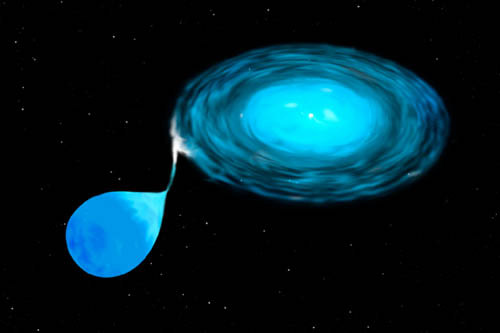Artist interpretation of NGC6624 (Produced by: Dana Berry/STScI) This is an illustration of a double star system at the heart of the globular cluster NGC 6624, located approximately 28,000 light-years away in the constellation Sagittarius. The star is a source of powerful bursts of X-ray emission. One member of the binary is a neutron star, an extremely dense and compact corpse of a massive star that exploded long ago. The neutron star is slowly devouring its larger but less-massive white- dwarf star companion, seen at lower left. Tidal forces from the neutron star's intense gravitation pull stretch the dwarf into an egg-shape. (A white dwarf is the remnant of a burned out Sun-like star.) Gas pulled from the dwarf flows across a narrow accretion bridge and then smear out into a swirling disk. The energy released by the continuous infall of gas onto the neutron star produces the steady X-ray emission. This gusher of radiation heats temperatures greater than 100,000 degrees Fahrenheit. The infall also supplies fuel for sporadic, intense X-ray bursts. These occur when enough gas accumulates on the surface of the neutron star to ignite spontaneously, creating an enormous nuclear fusion bomb. For a few seconds, the outburst abruptly outshines the usual steady X-ray emission. Click here for a larger gif.
IMAGES |
By Mission |
Stars |
HEASARC Home | Observatories | Archive | Calibration | Software | Tools | Students/Teachers/Public Last modified: Thursday, 26-Jun-2003 13:48:45 EDT |

